- Home
- Kurt Vonnegut
Bluebeard Page 4
Bluebeard Read online
Page 4
It was structures with such unusual dimensions, in fact, along with what used to be very cheap property, which caused many painters to move out here when I was young, and especially painters who were working on exceptionally large canvases. I would never have been able to work on the eight panels comprising "Windsor Blue Number Seventeen" as a single piece, if I hadn't rented that potato barn.
The nosy widow Berman, a.k.a. "Polly Madison," can't get into the studio or even take a peek inside because it has no windows and because two years ago, right after my wife died, I personally nailed the doors at one end shut from the inside with six-inch spikes, and immobilized the doors at the other end on the outside, from top to bottom, with six big padlocks and massive hasps.
I myself haven't been in there since. And, yes, there is something in there. This is no shaggy dog story. After I die and am buried next to my darling Edith, and the executors of my estate open those doors at last, they will find more than just thin air in there. And it won't be some pathetic symbol, such as a paintbrush broken in two or my Purple Heart on an otherwise vacant and clean-swept floor.
And there is no lame joke in there, like a painting of potatoes, as though I were returning the barn to potatoes, or a painting of the Virgin Mary wearing a derby and holding a watermelon, or some such thing.
And no self-portrait.
And nothing with a religious message.
Tantalizing? Here's a hint: it's bigger than a bread box and smaller than the planet Jupiter.
Not even Paul Slazinger has come close to guessing what is in there, and he has said more than once that he doesn't see how our friendship can continue, if I feel my secret would not be safe with him.
The barn has become quite famous in the art world. After I show visitors the collection in the house, most of them ask if they can see what is in the barn as well. I tell them that they can see the outside of the barn, if they like, and that the outside is in fact a significant landmark in art history. The first time Terry Kitchen used a paint-spraying rig, his target was an old piece of beaverboard he had leaned against the barn.
"As for what's inside the barn," I tell them, "it's the worthless secret of a silly old man, as the world will discover when I have gone to the big art auction in the sky."
5
ONE ART PUBLICATION claimed to know exactly what was in there: the very greatest of the Abstract Expressionist paintings, which I was keeping off the market in order to raise the value of relatively unimportant paintings in the house here.
Not true.
After that article was printed, my fellow Armenian in Southampton, Kevork Hovanissian, made a serious offer of three million dollars for everything in the barn, sight unseen.
"I wouldn't want to cheat you that way," I told him. "That would be un-Armenian."
If I had taken his money, it would have been like selling him Brooklyn Bridge.
One response to that same article wasn't that amusing. A man whose name I did not recognize, said in a letter to the editor that he had known me during the war, which he evidently did. He was at least familiar with my platoon of artists, which he described accurately. He knew the mission we were given after the German Air Force had been knocked out of the sky and there was no longer any need for the big-time camouflage jokes we played. This was the mission, which was like turning children loose in the workshop of Father Christmas: we were to evaluate and catalogue all captured works of art.
This man said he had served in SHAEF, and I must have dealt with him from time to time. It was his belief, as stated in his letter, that I had stolen masterpieces which should have been returned to their rightful owners in Europe. Fearing lawsuits brought by those rightful owners, he said, I had locked them up in the barn.
Wrong.
He is wrong about the contents of the barn. I have to say he is just a little bit right about my having taken advantage of my unusual wartime opportunities. I couldn't have stolen anything which was handed over by the military units which had captured it. I had to give them receipts, and we were visited regularly by auditors from the Finance Corps.
But our travels behind the lines did bring us into contact with persons in desperate circumstances who had art to sell. We got some remarkable bargains.
Nobody in the platoon got an Old Master, or anything which obviously came from a church or a museum or a great private collection. At least I don't think anybody did. I can't be absolutely sure about that. In the Art World, as elsewhere, opportunists are opportunists and thieves are thieves.
But I myself did buy from a civilian an unsigned charcoal sketch which looked like a Cezanne to me, and which has since been authenticated as such. It is now a part of the permanent collection of the Rhode Island School of Design. And I bought a Matisse, my favorite painter, from a widow who said her husband had been given it by the artist himself. For that matter, I got stuck with a fake Gauguin, which served me right.
And I sent my purchases for safekeeping to just about the only person I knew and could trust in the whole United States of America anymore, Sam Wu, a Chinese laundryman in New York City who was a cook for a little while for my former master, the illustrator Dan Gregory.
Imagine fighting for a country where the only civilian you know is a Chinese laundryman!
And then one day I and my platoon of artists were ordered into combat, to contain, if we could, the last big German breakthrough of World War Two.
But none of that stuff is in the barn, or even in my possession. I sold it all when I got home from the war, which gave me a nice little bankroll to invest in the stock market. I had given up my boyhood dream of being an artist. I enrolled in courses in accounting and economics and business law and marketing and so on at New York University. I was going to be a businessman.
I thought this about myself and art: that I could catch the likeness of anything I could see--with patience and the best instruments and materials. I had, after all, been an able apprentice under the most meticulous illustrator of this century, Dan Gregory. But cameras could do what he had done and what I could do. And I knew that it was this same thought which had sent the Impressionists and the Cubists and the Dadaists and the Surrealists and so on in their quite successful efforts to make good pictures which cameras and people like Dan Gregory could not duplicate.
I concluded that my mind was so ordinary, which is to say empty, that I could never be anything but a reasonably good camera. So I would content myself with a more common and general sort of achievement than serious art, which was money. I was not saddened about this. I was in fact much relieved!
But I still enjoyed engaging in the blather of art, since I could talk if not paint pictures as well as anyone. So I would go to bars around NYU at night, and easily made friends with several painters who thought they were right about almost everything, but who never expected to receive much recognition. I could talk as well as the best of them, and drink as much as they could. Best of all, I could pick up the check at the end of the evening, thanks to the money I was making in the stock market, subsistence payments I was receiving from the government while going to the university, and a lifetime pension from a grateful nation for my having given one eye in defense of Liberty.
To the real painters I seemed a bottomless pit of money. I was good not only for the cost of drinks, but for rent, for a down payment on a car, for a girlfriend's abortion, for a wife's abortion. You name it. However much money they needed for no matter what, they could get it from Diamond Rabo Karabekian.
So I bought those friends. My pit of money wasn't really bottomless. By the end of every month they had taken me for everything I had. But then the pit, a small one, would fill up again.
Fair was fair. I certainly enjoyed their company, especially since they treated me as though I were a painter, too. I was one of them. Here was another big family to replace my lost platoon.
And they paid me back with more than companionship. They settled their debts as best they could with pictures nobody wanted, too.
I almost forgot to say: I was married and my wife was pregnant at the time. She would be twice impregnated by that incomparable lover, Rabo Karabekian.
I have now returned to this typewriter from the vicinity of the swimming pool, where I asked Celeste and her friends in and around that public teenage athletic facility, if they knew who Bluebeard was. I meant to mention Bluebeard in this book. I wanted to know if I had to explain, for the sake of young readers, who Bluebeard was.
Nobody knew. While I was at it, I asked them if they recognized the names of Jackson Pollock, Mark Rothko, or Terry Kitchen, or Truman Capote, or Nelson Algren, or Irwin Shaw, or James Jones, all of whom had figured not only in the history of arts and letters but in the history of the Hamptons. They did not. So much for achieving immortality via the arts and letters.
So: Bluebeard is a fictitious character in a very old children's tale, possibly based loosely on a murderous nobleman of long ago. In the story, he has married many times. He marries for the umpteenth time, and brings his latest child bride back to his castle. He tells her that she can go into any room but one, whose door he shows her.
Bluebeard is either a poor psychologist or a great one, since all his new wife can think about is what might be behind the door. So she takes a look when she thinks he isn't home, but he really is home.
He catches her just at the point she is gazing aghast at the bodies of all his former wives in there, all of whom he has murdered, save for the first one, for looking behind the door. The first one got murdered for something else.
So--of all the people who know about my locked potato barn, the one who finds the mystery most intolerable is surely Circe Berman. She is after me all the time to tell her where the six keys are, and I tell her again that they are buried in a golden casket at the foot of Mount Ararat.
I said to her the last time she asked, which was about five minutes ago: "Look: think about something else, anything else. I am Bluebeard, and my studio is my forbidden chamber as far as you're concerned."
6
THE BLUEBEARD STORY notwithstanding, there are no bodies in my barn. The first of my two wives, who was and is Dorothy, remarried soon after our divorce, remarried happily, from all accounts. Dorothy is now a widow in a beachfront condominium in Sarasota, Florida. Her second husband was what we both thought I might become right after the war: a capable and personable insurance man. We each have a beach.
My second wife, dear Edith, is buried in Green River Cemetery out here, where I expect to be buried, too--only a few yards, in fact, from the graves of Jackson Pollock and Terry Kitchen.
If I killed anybody in the war, and I just might have, it would have been during the few seconds before a shell from somewhere knocked me unconscious and took out one eye.
When I was a two-eyed boy, I was the best draughtsman they had ever seen in the rinky-dink public school system of San Ignacio, which wasn't saying much. Several of my teachers were so impressed that they suggested to my parents that perhaps I should pursue a career as an artist.
But this advice seemed so impractical to my parents that they asked the teachers to stop putting such ideas in my head. They thought that artists lived in poverty, and that they had to die before their works were appreciated. They were generally right about that, of course. The paintings by dead men who were poor most of their lives are the most valuable pieces in my collection.
And if an artist wants to really jack up the prices of his creations, may I suggest this: suicide.
But in 1927, when I was eleven years old, and was incidentally well on my way to becoming as good a cobbler as my father, my mother read about an American artist who made as much money as many movie stars and tycoons, and was in fact the friend and equal of movie stars and tycoons, and had a yacht--and a horse farm in Virginia, and a beach house in Montauk, not far from here.
Mother would say later, and not all that much later, since she had only one more year to live, that she never would have read the article if it hadn't been for a photograph of this rich artist on his yacht. The name of the yacht was the name of the mountain as sacred to Armenians as Fujiyama is to the Japanese: Ararat.
This man had to be an Armenian, she thought, and so he was. The magazine said he had been born Dan Gregorian in Moscow, where his father was a horse trainer, and that he had been apprenticed to the chief engraver of the Russian Imperial Mint.
He had come to this country in 1907 as an ordinary immigrant, not a refugee from any massacre, and had changed his name to Dan Gregory, and had become an illustrator of magazine stories and advertisements, and of books for young people. The author of the article said he was probably the highest paid artist in American history.
That could still be true of Dan Gregory, or "Gregorian," as my parents always called him, if his income in the 1920s, or especially during the Great Depression, were translated into the depreciated dollars of today. He could still be the champ, living or dead.
My mother was shrewd about the United States, as my father was not. She had figured out that the most pervasive American disease was loneliness, and that even people at the top often suffered from it, and that they could be surprisingly responsive to attractive strangers who were friendly.
So my mother said to me, and I hardly recognized her, so sly and witchlike had her face become: "You must write to this Gregorian. You must tell him that you are also Armenian. You must tell him that you want to be an artist half as good as he is, and that you think he is the greatest artist who ever lived."
So I wrote such a letter, or about twenty such letters, in my childish longhand, until Mother was satisfied that the bait was irresistible. I did this hard work in an acrid cloud of my father's raillery.
He said things like "He stopped being an Armenian when he changed his name," and "If he grew up in Moscow, he's a Russian not an Armenian," and "You know what a letter like that would mean to me? 'The next one asks for money.'"
And Mother said to him in Armenian: "Can't you see we're fishing? If you make so much noise talking, you'll scare the fish away."
In Turkish Armenia, incidentally, or so I've been told, it was the women and not the men who were the fisherfolk.
And what a terrific bite my letter got!
We hooked Dan Gregory's mistress, a former Ziegfeld Follies showgirl named Marilee Kemp!
This woman would become the very first woman I ever made love to--at the age of nineteen! And, oh, my God, what a fuddy-duddy old poop I am, thinking about that sexual initiation as though it were as marvelous as the Chrysler Building--while the fifteen-year-old daughter of my cook is taking birth-control pills!
Marilee Kemp said that she was Mr. Gregory's assistant, and that she and he had been deeply moved by my letter. Mr. Gregory, as I might imagine, was a very busy man, and had asked her to reply for him. This was a four-page letter, written in a scrawl almost as childish as my own. She was then only twenty-one years old--the daughter of an illiterate coal miner in West Virginia.
When she was thirty-seven, she would be the Countess Portomaggiori, with a pink palace in Florence, Italy. When she was fifty, she would be the biggest Sony distributor in Europe, and that old continent's greatest collector of American postwar modern art.
My father said she had to be crazy to write such a long letter to a stranger, and nothing but a boy at that, so far away.
Mother said she must be very lonely, which was true. Gregory kept her as a pet around the house, because she was so beautiful, and he used her as a model sometimes. But she was certainly no assistant in his business. He had no interest in her opinions about anything.
He never included her in his dinner parties, either, never took her on trips or to a show or out to restaurants or to other people's parties, or introduced her to his famous friends.
Marilee Kemp wrote me seventy-eight letters between 1927 and 1933. I can count them because I still have them, now bound in a hand-tooled leather volume in a slipcase in the library. The binding and slipcase were a gift from d
ear Edith on our tenth wedding anniversary. Mrs. Berman has found it, as she has found everything of any emotional significance here but the keys to the barn.
She has read all the letters without first asking me if I considered them private, which I surely do. And she has said to me, and this is the first time she has ever sounded awed: "Just one of this woman's letters says more wonderful things about life than every picture in this house. They're the story of a scorned and abused woman discovering that she was a great writer, because that is what she became. I hope you know that."
"I know that," I said. It was certainly true: each letter is deeper, more expressive, more confident and self-respecting than the one before.
"How much education did she have?" she asked.
"One year of high school," I said.
Mrs. Berman shook her head in wonder. "What a year that must have been," she said.
As for my side of the correspondence: my main messages were pictures I had made, which I thought she would show to Dan Gregory, with brief notes attached.
After I told Marilee that Mother had died of tetanus from the cannery, her letters became very motherly, although she was only nine years older than me. And the first of these motherly letters came not from New York City but from Switzerland, where, she said in the letter, she had gone to ski.
Only after I visited her in her palace in Florence after the war did she tell me the truth: Dan Gregory had sent her alone to a clinic there to get rid of the fetus she was carrying.
"I should have thanked Dan for that," she said to me in Florence. "That's when I got interested in foreign languages." She laughed.
Mrs. Berman has just told me that my cook has had not just one abortion, like Marilee Kemp, but three--and not in Switzerland but in a doctor's office in Southampton. This wearied me, but then, almost everything about the modern world wearies me.
I didn't ask where the cook's carrying Celeste for a full nine months fit in with the abortions. I didn't want to know, but Mrs. Berman gave me the information anyway. "Two abortions before Celeste, and one after," she said.

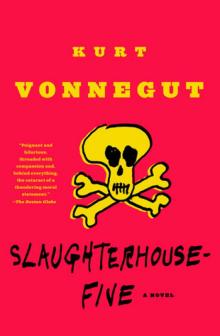 Slaughterhouse-Five
Slaughterhouse-Five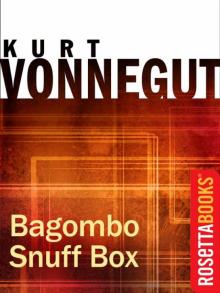 Bagombo Snuff Box: Uncollected Short Fiction
Bagombo Snuff Box: Uncollected Short Fiction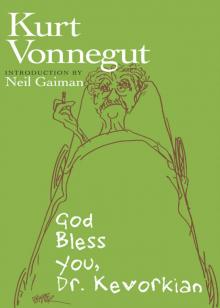 God Bless You, Dr. Kevorkian
God Bless You, Dr. Kevorkian Breakfast of Champions
Breakfast of Champions While Mortals Sleep: Unpublished Short Fiction
While Mortals Sleep: Unpublished Short Fiction Slapstick or Lonesome No More!
Slapstick or Lonesome No More! Cat's Cradle
Cat's Cradle The Sirens of Titan
The Sirens of Titan A Man Without a Country
A Man Without a Country Look at the Birdie: Unpublished Short Fiction
Look at the Birdie: Unpublished Short Fiction Bluebeard
Bluebeard Hocus Pocus
Hocus Pocus The Big Trip Up Yonder
The Big Trip Up Yonder Palm Sunday: An Autobiographical Collage
Palm Sunday: An Autobiographical Collage Jailbird
Jailbird Happy Birthday, Wanda June
Happy Birthday, Wanda June Welcome to the Monkey House
Welcome to the Monkey House Player Piano
Player Piano Fates Worse Than Death: An Autobiographical Collage
Fates Worse Than Death: An Autobiographical Collage Love, Kurt
Love, Kurt Timequake
Timequake God Bless You, Mr. Rosewater
God Bless You, Mr. Rosewater 2 B R 0 2 B
2 B R 0 2 B The Eden Express: A Memoir of Insanity
The Eden Express: A Memoir of Insanity Mother Night
Mother Night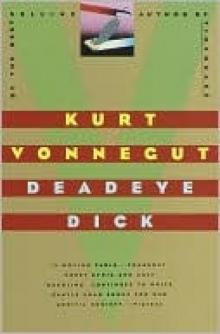 Deadeye Dick
Deadeye Dick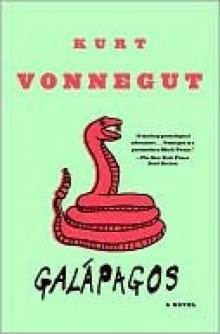 Galápagos
Galápagos Palm Sunday
Palm Sunday We Are What We Pretend to Be
We Are What We Pretend to Be Look at the Birdie
Look at the Birdie Basic Training
Basic Training Armageddon in Retrospect
Armageddon in Retrospect Basic Training (Kindle Single)
Basic Training (Kindle Single) If This Isn't Nice, What Is?
If This Isn't Nice, What Is? Bagombo Snuff Box
Bagombo Snuff Box The Petrified Ants
The Petrified Ants Cat's Cradle: A Novel
Cat's Cradle: A Novel Fates Worse Than Death: An Autobiographical Collage (Kurt Vonnegut Series)
Fates Worse Than Death: An Autobiographical Collage (Kurt Vonnegut Series)